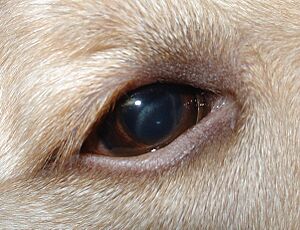Morgan's canon facts for kids
Morgan's Canon is a simple but important rule about understanding how animals behave. It says that when we see an animal do something, we should always try to explain it in the easiest way possible. This rule was created by a British scientist named C. Lloyd Morgan.
Contents
What is Morgan's Canon?
Morgan's Canon is a rule for studying animal behavior. It tells us to explain what animals do in the simplest way possible. It was named after a British psychologist named C. Lloyd Morgan.
Keeping Explanations Simple
C. Lloyd Morgan believed we should not assume animals are thinking or feeling complex human emotions. For example, we should not say an animal is "rational" or "affectionate" unless there is no other way to explain its actions. He thought it was always best to start with the simplest idea first.
He famously said that we should never explain an animal's action using complex thoughts if a simpler explanation works. This means if an animal's behavior can be understood as a basic reaction, we should choose that explanation. We should not assume it is a sign of deep thinking.
Learning by Trial and Error
Morgan noticed that many animal actions that seemed smart could be explained by "trial and error" learning. This is when an animal tries different things until one works. Then, it remembers what worked for next time.
A famous example is Morgan's own dog, Tony. Tony learned how to open the garden gate. Someone watching Tony might think the dog was very smart and figured it out all at once. But Morgan had watched Tony many times. He saw how the dog slowly learned the steps. Tony tried different things until he found the right way to open the gate. This showed that Tony did not need to "think" like a human to open the gate. He just learned through practice.
Morgan's Canon and Behaviorism
Morgan's Canon was an early idea that helped lead to Behaviorism. Behaviorism is a way of studying behavior that focuses on what can be seen and measured. It tries to explain actions without guessing about an animal's inner thoughts or feelings.
Related pages
Images for kids



